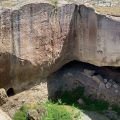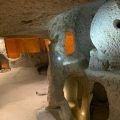A Journey into the Past
Imagine a city where the streets are underground corridors, homes are carved into rock, and the sky is a ceiling of stone. Welcome to Derinkuyu Underground City in the Cappadocia region of Turkey—a hidden world where history, mystery, and ingenuity converge. For history enthusiasts, travel bloggers, and archaeology buffs, Derinkuyu is more than just an ancient city; it’s a walk through time itself. This blog post will take you through the intricacies of its history, the marvels of its architecture, and why it remains a captivating destination for explorers today.
Earliest Beginnings with the Hittites
The story of Derinkuyu begins with the Hittites, an ancient civilization that thrived between 1600 BCE and 1200 BCE. Faced with constant threats from marauding forces, the Hittites sought refuge beneath the earth’s surface. They began carving out spaces within the soft volcanic rock of Cappadocia, creating what would be the foundations of Derinkuyu. This underground shelter was not only a defense mechanism but also a testament to their ingenuity and adaptability.
These early subterranean chambers served as a safe haven, protecting the Hittites from invaders. The intricate tunnels and rooms allowed them to survive sieges, and the natural insulation provided a stable climate year-round. Even in the depths, they managed to sustain life seamlessly, demonstrating remarkable resourcefulness.
The Hittites’ initial efforts laid the groundwork for a complex society below the surface. Over time, other civilizations built upon these foundations, expanding the underground labyrinth into a vast network of passageways and rooms.
Expansion by Successive Civilizations
Following the decline of the Hittites, Derinkuyu continued to evolve under the stewardship of the Phrygians, Persians, Greeks, and Romans. Each group brought their own innovations, enhancing the city’s functionality and complexity. They expanded the city further, adding levels and refining its design to accommodate varying needs.
The Phrygians, known for their cultural richness, contributed to the aesthetic elements of the city. The Persians, with their advanced engineering skills, improved the structural integrity of the underground spaces. Meanwhile, the Greeks and Romans added to the architectural diversity, incorporating elements from their own advanced societies.
This continued development ensured that Derinkuyu remained a thriving hub for centuries. The layers of historical influence can still be seen today, each testament to the blended cultures that once called this underground city home.
Sanctuary for Early Christians
As Christianity spread across the Roman Empire, its followers often faced persecution. For the early Christian communities in Cappadocia, the Derinkuyu Underground City became a sanctuary. Here, they found protection from their oppressors, as its hidden chambers shielded them from the outside world.
The city’s labyrinthine design proved invaluable, allowing Christians to practice their faith in secret. Hidden chapels and meeting rooms provided spaces for worship and gatherings, away from prying eyes. The sanctity of Derinkuyu during this time illustrates how faith and perseverance can thrive even in the harshest conditions.
The city’s design, with its maze of passages and secure entry points, made it difficult for outsiders to penetrate. This offered an additional layer of security, granting its inhabitants peace of mind in a period of turmoil.
Byzantine Bastion Against Invaders
During the Middle Ages, the Byzantine Empire transformed Derinkuyu into a fortified stronghold against the advancing Arab armies. The city was expanded significantly, with new defensive structures and reinforced walls to withstand potential sieges.
Ingenious fortifications included rolling stone doors that could seal off passages, while narrow corridors limited the movement of intruders. These tactical innovations ensured that Derinkuyu remained unconquered, preserving its status as a bastion of safety.
The Byzantines’ efforts extended beyond mere survival; they aimed to create a sustainable community within the depths. With resourceful planning, they maintained a resilient society under constant threat, showcasing their strategic prowess.
Rediscovery in the 20th Century
The enigmatic allure of Derinkuyu might have remained hidden if not for a serendipitous accident in the 20th century. In 1963, a Turkish homeowner stumbled upon a mysterious passageway while renovating his house. Curiosity piqued, he continued to explore, eventually unearthing the vast underground city that lay dormant for centuries.
This rediscovery sparked global interest and a renewed fascination with the ancient world. Archaeologists and historians flocked to Derinkuyu, eager to unravel its secrets and learn from its past. The revelation of this subterranean wonder reintroduced Derinkuyu to the world stage, emphasizing its significance as a historical marvel.
The excitement surrounding its rediscovery led to extensive studies and preservation efforts. Today, Derinkuyu stands as a testament to human resilience and the enduring spirit of exploration.
A Marvel of Ancient Engineering
Beneath the surface, Derinkuyu reveals an intricate system of engineering feats that boggle the modern mind. The ventilation shafts ensure a steady supply of fresh air, circulating it throughout the expansive underground maze. Wells and water channels were meticulously constructed, providing essential resources for survival.
These engineering marvels highlight the sophistication of ancient builders, whose techniques and solutions were well ahead of their time. The careful planning of drainage systems and waste disposal ensured that the city remained habitable even during long periods of occupation.
The layout of the city, with its multi-level design and interconnected chambers, demonstrates a deep understanding of both functionality and safety. It remains an enduring testament to the ingenuity of its ancient inhabitants.
A Popular Tourist Attraction and UNESCO Site
Today, Derinkuyu Underground City stands as one of Turkey’s most fascinating tourist attractions and holds the esteemed status of a UNESCO World Heritage site. Visitors flock to explore its labyrinthine corridors and marvel at the ingenuity of its ancient builders.
Guided tours lead adventurers through the city’s corridors, offering glimpses into its storied past. Travelers can wander through living spaces, kitchens, wineries, stables, and even a chapel—each room echoing with tales of history.
The city’s significance extends beyond its historical value; it serves as a vivid reminder of human adaptability and resourcefulness. Derinkuyu continues to captivate and inspire, drawing travelers and scholars alike into its enigmatic depths.
Unearthing Cultural Significance
Derinkuyu is more than just an underground city; it is a cultural treasure trove that offers insights into the lives of ancient civilizations. The artifacts unearthed here provide glimpses into the daily existence of its inhabitants, revealing aspects of their culture, religion, and social dynamics.
The city’s strategic location within Cappadocia, a region rich in history and culture, further adds to its allure. Visitors can immerse themselves in the broader context of the area, connecting Derinkuyu to the broader tapestry of human history.
By exploring Derinkuyu’s chambers, travelers gain a deeper appreciation for the diversity and resilience of past societies. It serves as a bridge between worlds, inviting contemporary audiences to reflect on the legacy of those who came before.
Planning Your Visit
For travelers eager to experience Derinkuyu firsthand, planning a visit is an adventure in itself. The city is easily accessible from nearby towns such as Nevşehir and Göreme, making it a convenient stop on a Cappadocia itinerary.
Visitors are encouraged to join guided tours to fully appreciate the city’s historical and architectural significance. Knowledgeable guides provide insights into the secrets and stories of Derinkuyu, ensuring a memorable and educational experience.
Exploring the city requires a sense of wonder and curiosity, as well as comfortable walking shoes for navigating its subterranean paths. The experience promises to be both enlightening and awe-inspiring, leaving a lasting impression on all who venture within.
Capturing the Essence of Derinkuyu
Photography enthusiasts will find Derinkuyu a visual feast, with its unique architecture and atmospheric lighting providing endless opportunities for captivating shots. The interplay of light and shadow within the tunnels creates an otherworldly ambiance, perfect for artistic expression.
Capturing the essence of Derinkuyu extends beyond photographs; it involves immersing oneself in its history, absorbing the stories etched into its walls. It’s about experiencing the echoes of the past and sharing those moments with others who seek inspiration.
For travelers and adventurers, documenting the journey through Derinkuyu becomes a way to connect with a wider community of history enthusiasts and explorers.
Conclusion
Derinkuyu Underground City is a remarkable testament to human ingenuity, resilience, and adaptability. Its legacy spans millennia, encompassing diverse civilizations and cultures that have left their mark within its subterranean depths.
For history enthusiasts, travel bloggers, and archaeology buffs, Derinkuyu offers a rare opportunity to step back in time and explore a world hidden beneath the surface. It invites us to reflect on the interconnectedness of humanity and the enduring spirit that drives us to overcome challenges.
Whether you’re a seasoned traveler or an armchair explorer, Derinkuyu’s mysteries await your discovery. Embark on a journey to Cappadocia, and uncover the secrets of this ancient underground city—a timeless marvel that continues to inspire and captivate.




